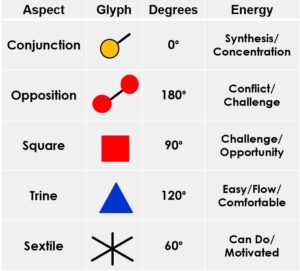
The previous article on Aspects provided an introduction to aspects and highlighted the conjunction and hard aspects. In this post, the soft aspects of trines and sextiles will be covered as well as the relative strength, or orb, which applies to the delineation of aspects.
Soft Aspects
The trine and sextile are often referred to as soft aspects, and they suggest an energy between planets which is easy, flowing and innate. These aspects suggest cooperation between the energies of two (or more) planets and can reflect innate talents, things that come easily or naturally to the individual. As such, they offer opportunities for creativity; however, if there are too many easy aspects within a chart, there can be very little for a person to strive for.
Trine
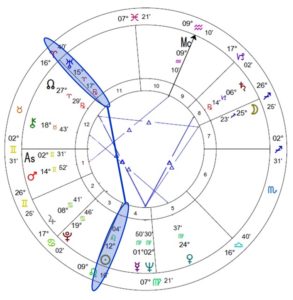 KEYWORDS: flow, ease, inspiration, harmony, comfortable, natural
KEYWORDS: flow, ease, inspiration, harmony, comfortable, natural
Traditionally the Trine has been viewed as beneficial, indicating a degree of harmony and ease between the planets or angles involved. It reflects a talent in the individual which is innate, and often the energy is creative or artistic in nature. Trines tend to reflect things one does with ease requiring no focused energy or effort. Since there is no pressing need to take action individuals who have Trines in their chart, do not always take full advantage of them. The most beneficial use of a Trine may be to use the natural energies it represents to help support efforts in more challenging areas. Trines are 120° or four zodiac signs apart.
Highlighted here is the Sun in Leo in the 4th House trine Uranus in Aries in the 11th House. Additional trines are present in the chart as reflected by the blue lines; you may note these as well to become more familiar with this aspect relationship.
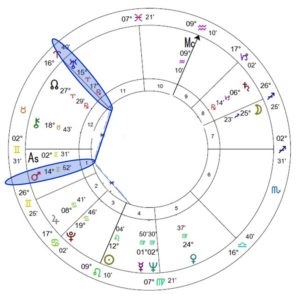
Sextile
KEYWORDS: opportunity, attraction, ease, affability, skill
Sextiles are usually identified as being positive with an easeful type of energy and are often likened to the Trine. The Sextile provides a natural flow of energy that can work in one’s favor and play to their strengths or talents, thus helping the individual reach their goals…if they take action. However, while a Trine represents an innate talent, the Sextile only provides an opportunity that requires some effort to achieve the potential benefit. Recognizing the sextiles within a chart can aid in identifying opportunities for progress and action that may support more challenging aspects within the horoscope.
A sextile is highlighted here showing Mars in Gemini in the 1st House sextile Uranus in Aries in the 11th House.
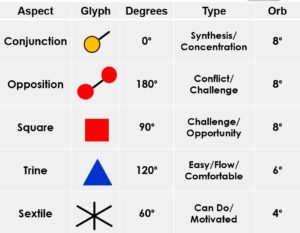
Orbs
The deviation (or variance) from an exact degree in any aspect (0°00’ is exact) is known as the ‘orb’. The tightest aspects, or those with the least amount of deviation, are considered the most influential while looser aspects, or those with wider deviations, have less influence. The orb, or the degree of the variation, used to consider the planetary relationship in a chart delineation varies depending on the aspect.
The chart here provides a helpful reference when delineating chart aspects. For the more powerful aspects, a rule of thumb is to allow an 8° orb, while the less powerful aspects such as the trine and sextile suggest a smaller orb of 6° and 4° respectively. There is one qualifier to consider here which involves the luminaries, and in the case of an aspect with the Sun or the Moon, many astrologers allow for a 10° orb.
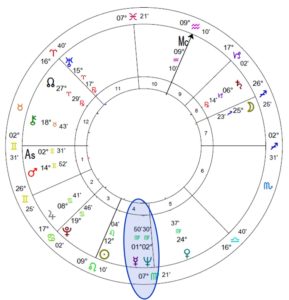
Examples:
In this conjunction shows Mercury at 01°50’ of Virgo with Neptune at 02°30’ of Virgo, representing an orb, or variance, of 0°40’ (40 minutes). Less than 1° separates the two planets and, with an allowable orb of 8° for a conjunction, this is considered a tight orb.
This second example shows two trines. Conjunction shows Mercury at 01°50’ of Virgo with Neptune at 02°30’ of Virgo, representing an orb, or variance, of 0°40’ (40 minutes). Less than 1° separates the two planets and, with an allowable
Join author, life coach, and astrologer, Jayne Logan in an exploration into the basic and foundational principles of astrology.
Astrology Basics is a 6 session series introduction to the complex world of astrology. It is suitable for beginners, new students, or anyone with a general interest in the topic. The program will take you through the basics while offering an entre into the unique language of this ancient art, in an easy-to-understand and visual format. A different topic is presented in each lesson, each one building on the previous lesson. At the end of the series you will have a foundational understanding of the components of a horoscope and some basic tools to synthesize the information.

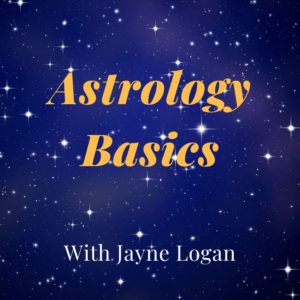






Join the Conversation